
- 八王子キャンパス
教育学部 初等教育学科 こども教育コース

- 八王子キャンパス

子どもと一緒に学び可能性を広げる
幼稚園教諭・保育士を養成します
こども教育コースでは、子どもと一緒に学びながらその可能性を広げることができる幼稚園教諭・保育士の養成をめざしています。資格取得に関する学習を中心に、教育学・心理学など幅広い分野のカリキュラムのなかで学んでいきます。子どもたちと接する現場での質の高い学びを通して、子どもを理解する能力や感性を育てながら、教員・保育士としての実践力・即戦力を身につけます。

ライフデザイン演習Ⅰ
初年次教育科目であるこの授業では、学生が自分に合った学び方を身につけ、将来についても考えながら計画的に大学生活を送れるように、高校から大学への円滑な移行を支援します。こども教育コースの特性に応じた指導として、1年前期に全員が大学の敷地内にある帝京大学幼稚園の見学を行い、砂遊びやかけっこ、園庭の遊具での遊びなどを通して子どもとのふれあいを体験します。学生からは「子ども達がどんな遊びをして、どうやって友達と接しているかを観察できた」「実際に子ども達とふれあうことで気づくことがたくさんあった」「保育の道に進みたいという意志が強まった」などの声があります。

保育内容の指導法(人間関係Ⅰ)
子どもは、仲間や保育者との生活、遊びを通して人間関係能力を育みます。本授業は、子どもたちが「ほかの人びとと親しみ支え合って生活するために、自立心を育て、人とかかわる力を養う」ために保育者がどのような支援をすれば良いのかを考える授業です。学生は、子どもの育ちを支える生活の仕方や遊びを計画し、保育者役と子ども役に分かれ模擬保育を行い、振り返りを通して保育を改善する力を身につけます。
ライフデザイン演習などでスタディ・スキルを向上させるとともに、理論的・専門的な学びとして教育学の各科目を履修します。併行して1年次から帝京大学幼稚園や地域の保育所、幼稚園、福祉施設でのボランティア活動に参加し、実践的・臨床的に学びます。3・4年次は主体的に演習や卒業研究に取り組み、学びの総仕上げを行います。
障害児保育
現在、多くの保育所・幼稚園・こども園では、障がいのある子どもとそうでない子どもが共に生活をしています。授業では、インクルーシブ保育の考え方を基本として、発達障がいをはじめ、保育者が実際に出会うことが想定される障がいを中心に、基礎的な知識を学びます。そのうえで、保育所・幼稚園・こども園での子どもの姿について事例などをもとに具体的に理解し、保育の在り方や支援の在り方について学んでいきます。さらに、障がいのある子どもの保護者や専門機関との連携などについて学んでいきます。授業にはグループワークを取り入れ、協同で学び理解を深めることを重視しています。
保育実習指導
保育士資格を取得するためには、3回の保育実習を行うことが必要です。実習を行うには、実習に関するさまざまな準備と実習終了後の振り返りが重要です。その準備と振り返りを行う授業が、実習指導です。担当教員の授業や個別面接を通して、自分自身の課題を明確にして、実習に臨みます。一人ひとりの学生の課題に合わせて、丁寧な指導を行っていきます。初めての保育実習は、2年次の春休みに保育所で2週間行います。次に、3年次の夏休みに施設で2週間、主に児童養護施設・乳児院・障がい者支援施設などの入所施設で実習を行います。4年次で行う最後の保育実習は、将来の方向性や自分の課題に添って、保育所か施設かを自分で選択します。さらに、学生自身が実習先を自己開拓し、一人ひとりの学生が「自分流」の実習を行えることは、帝京大学ならではの特色です。
乳児保育Ⅰ・Ⅱ
乳児保育という言葉を聞くと、子どもが誕生してから数年間の子どもの成長・発達を考えることが多いのではないでしょうか。しかし乳児保育とは、子どもが誕生する前の胎児期からの成長・発達を学ぶことが重要です。本科目は通年を通しての授業で、前期は胎児期から3歳未満児までの子どもの成長・発達について映像などを通して具体的に学びます。後期は、前期の学びを踏まえながら、指導案の作成や乳児のおもちゃを製作するなどより実践的な取り組みをしていきます。
GPA(Grade Point Average)制度の導入の趣旨は、1. キャンパスとして統一した基準を作成すること、2. 公平性に優れた基準であること、3. 国際的に通用する基準であることとし、学修の成果をGPAという客観的な数値で評価するものです。またこの制度は、欧米の大学で採用されている成績評価制度に概ね準拠しており、海外留学、海外の大学院進学、外資系企業への就職などの際に学力を証明する指標として、海外でも通用する成績評価制度となっています。
| 区分 | 評価 | GPA | 成績評価基準 | 評価内容 | 英文内容 |
|---|---|---|---|---|---|
| 合格 | S | 4.0 | 90点以上 | 特に優れた成績を表します | Excellent |
| A | 3.0 | 80点台 | 優れた成績を表します | Good | |
| B | 2.0 | 70点台 | 妥当と認められる成績を表します | Satisfactory | |
| C | 1.0 | 60点台 | 合格と認められる最低限の成績を表します | Pass | |
| 不合格 | D | 0.0 | 60点未満 | 合格と認められる最低限の成績に達していないことを表します。また、授業等の出席日数不足および当該授業における試験の未受験等も含みます | Failure |
| 対象外 | N | - | - | 編入や留学等により他大学等で修得した科目を本学の単位として認定したことを表します(単位認定科目) | Credits Transferred |

| 科目区分 | 必修・選択の例 | 所要単数 | |||||
|---|---|---|---|---|---|---|---|
| 共 通 教 育 科 目 ※4 | 教養 教育科目 | 人文科学系分野 | 選択必修 | 2以上 | 8以上 | 30※1 | |
| 社会科学系分野 | 2以上 | ||||||
| 自然科学系分野 | 2以上 | ||||||
| 文理融合分野 | 選択 | - | |||||
| 初年次 教育科目 | ライフデザイン演習Ⅰ・Ⅱ | 必修 | 2 | ||||
| キャリア教育科目 | 選択必修 | 2 | |||||
| 情報教育科目 | 選択必修 | 2 | |||||
| 外国語 教育科目 | 現代英語Ⅰ・Ⅱ・Ⅲ・Ⅳ | 必修 | 4 | ||||
| 専門科目※4 | 必修 | 16 | 74※3 | ||||
| 選択 必修※2 | 教育学系 科目 | 10 | |||||
| 現代教育 課題系科目 | 4 | ||||||
| 選択 | 44 | ||||||
| 自由選択 | ・専門科目74単位の超過単位 ・共通教育科目30単位の超過単位 ・オープン科目の修得単位 ・副専攻プログラムの修得単位 ・他大学での認定単位 | 選択 | 20 | ||||
| 合計 | 124 | ||||||